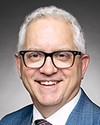Good afternoon. It is my great pleasure to be here this afternoon with you to provide my words around how Canada can support innovative and sustainable solutions to provide restitution of land to first nations, Inuit and Métis peoples across Canada.
First, let me recognize that today I am speaking on the unceded traditional lands of the Algonquin people.
Let me introduce myself and provide some context for why I'm here today.
My name is Sean Willy and I am both a Denesuline and a fifth-generation Canadian. I'm a member of the Deninu K'ue First Nation, which is located in the Northwest Territories. In my professional career, I am the president and CEO of the Des Nedhe Group, which is the English River First Nation's economic development corporation.
Of most importance to me is where I come from. I was born and raised throughout Canada's north. Born in Inuvik, Northwest Territories, I've lived in Fort McPherson, Rankin Inlet, Nunavut and Yellowknife, Northwest Territories. I grew up in a family with a Métis-Dene mother and a mining executive father.
I'm proud to say that I started in the gold mines of the Northwest Territories as a local indigenous hire. Why did they hire me? Well, the resource companies were forced to hire local indigenous people as part of their permits, so I began a long and healthy career in the resource industry.
English River First Nation has also had a long working history in the resource industry with the uranium mining industry in northern Saskatchewan. As with any relationship, it has its ongoing partnerships' ups and downs, but what English River saw was opportunity. The community leaders saw that the world wanted and needed the world-class uranium deposits found on their traditional lands. They knew they could support this development and better their communities through the creation of businesses geared to work with uranium mining companies. Over the past 30 years, this has evolved into Des Nedhe Group, one of the most progressive tier one first nation-owned and driven entities in Canada.
Des Nedhe is composed of many distinctive business drivers. The heart of Des Nedhe is its industrial division, which was born out of our interactions with the northern Saskatchewan resource industry. This includes Des Nedhe's first company, Tron Construction and Mining; our civil earthmoving company, Neetah Construction; and our underground mine builder, Mudjatik Thyssen, which is one of the most innovative partnerships in the country.
We have strong retail and property divisions, which contain the busiest Petro-Canadas in the province of Saskatchewan, multiple other gas stations, convenience stores, grocery stores and one of Canada's few liquor stores located on first nation reserve lands, which is in Saskatoon. Des Nedhe also owns multiple investment opportunities, from steel fabrication companies to trucking partnerships and marketing and communications firms. However, one of the most exciting entities we own, govern and manage is English River's land development opportunities.
One question posed within this standing committee is this: How can we undertake a study on the restitution of land to first nations, Inuit and Métis peoples? Of special interest is how this could lead to economic development and growth opportunities across Canada.
I can't dive into solving the whole issue in five minutes, so I'm happy to answer any questions, but I will share with you English River and Des Nedhe's story of how they secured additional lands to help promote economic development.
English River's leadership was and still is very pragmatic when it comes to life and business. English River leadership took advantage of the outstanding leadership among Saskatchewan first nation groups when they all pushed for past wrongs when it comes to land entitlement. The creation of the treaty land entitlement process and programs in Saskatchewan in the late nineties fixed these past wrongs for communities such as English River. English River was provided the opportunity financially to purchase additional acres of allocated Crown and private lands to make up for misallocations of reserve lands when the treaty was signed.
English River did not sit idle. They secured thousands of acres in their traditional hunting, trapping and fishing lands in northern Saskatchewan. They then purchased additional lands south of the city of Saskatoon strictly for economic development purposes. Thus, the Grasswoods reserve was born. They were planning ahead to help them create future revenue centres that would accentuate their northern resource revenues. This was done in the late nineties.
Des Nedhe was tasked with developing the Grasswoods economic development lands. Saskatoon, over this 20-year period, has now grown adjacent to the Grasswoods reserve, but the city never planned on supporting the reserve lands, so no services have been provided over the last 20 years, such as infrastructure for sewage and waste-water piping. When we discussed this with the city in 2018, they advised that they would not be building infrastructure out our way for the next 40 years.
At Des Nedhe, we took matters into our own hands. We applied for funding from Indigenous Services Canada to build our own high-technology waste-water treatment facility and secured $2.3 million. We then approached, and negotiated and signed an agreement with, the Canada Infrastructure Bank to finance the development of that facility and others that were needed to finish the infrastructure off. Last, we partnered with the local rural municipality of Corman Park to agree to work together and allow them access to our infrastructure, thus supporting each other's growth and creating a long-term revenue driver for the first nation.
These partnerships highlight what can be done to unlock the potential of first nation lands when we create the right value proposition. In this example, everybody wins. The rural municipality wins with the higher tax assessment rates now that the lands are serviced by a first nation. Local developers win because they can sell smaller lots at higher value due to not needing to sell large land sizes for septic fields. The local landowners win, as their land values have gone up in price because of first nation involvement. The environment wins because we are moving away from lagoons or septic fields, which are predominant in Saskatchewan, to a state-of-the-art waste-water treatment facility.
English River, through proactive and pragmatic leadership, is securing additional lands and has set up a very strong example of how to reclaim your lands for the betterment of your first nation. They have created a truly leading-edge practice. They are the only first nation that owns urban lands ready for long-term urban development, and control some of the richest lands full of the high-grade uranium needed to power a clean-energy transition.
Thank you very much.



